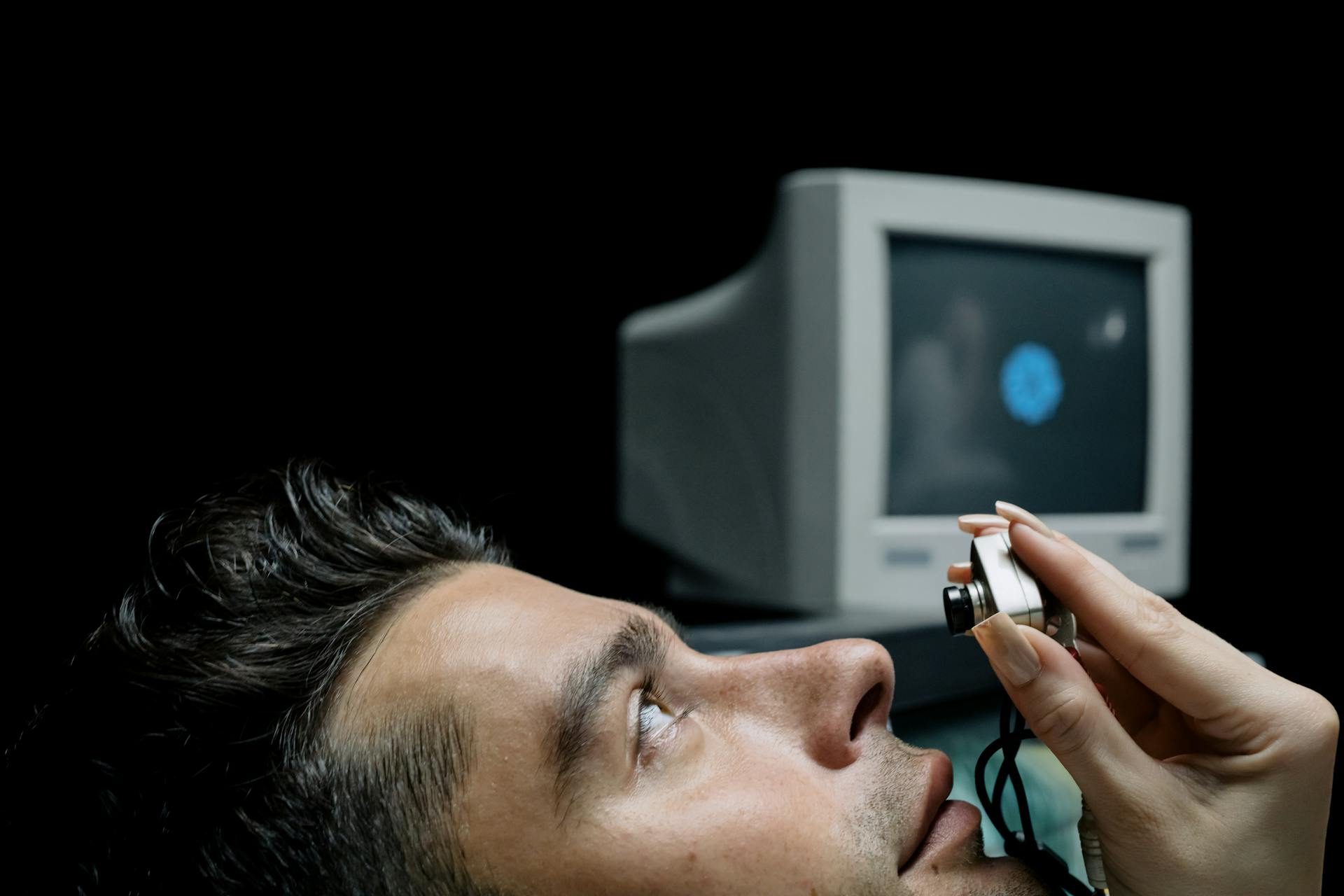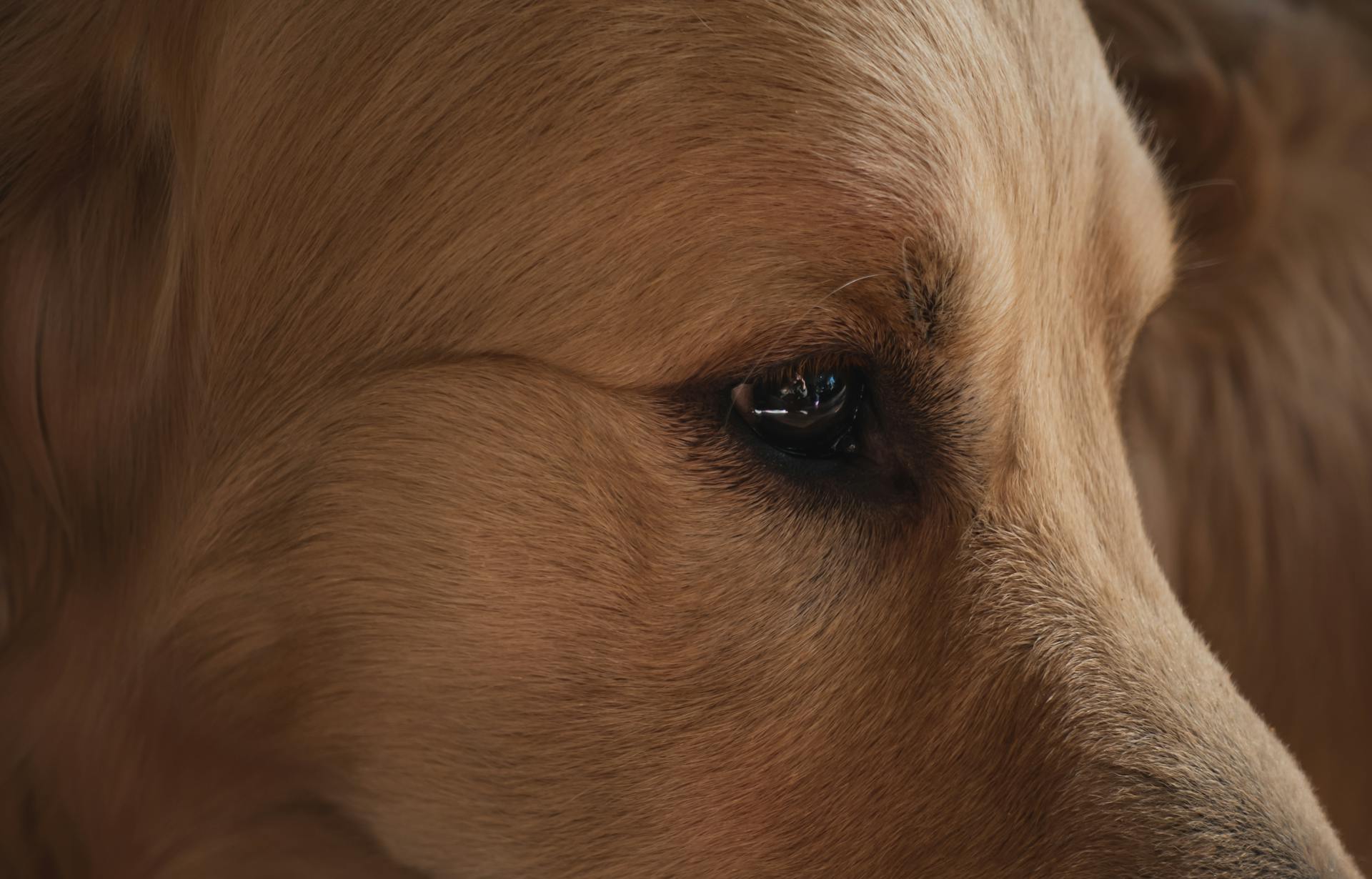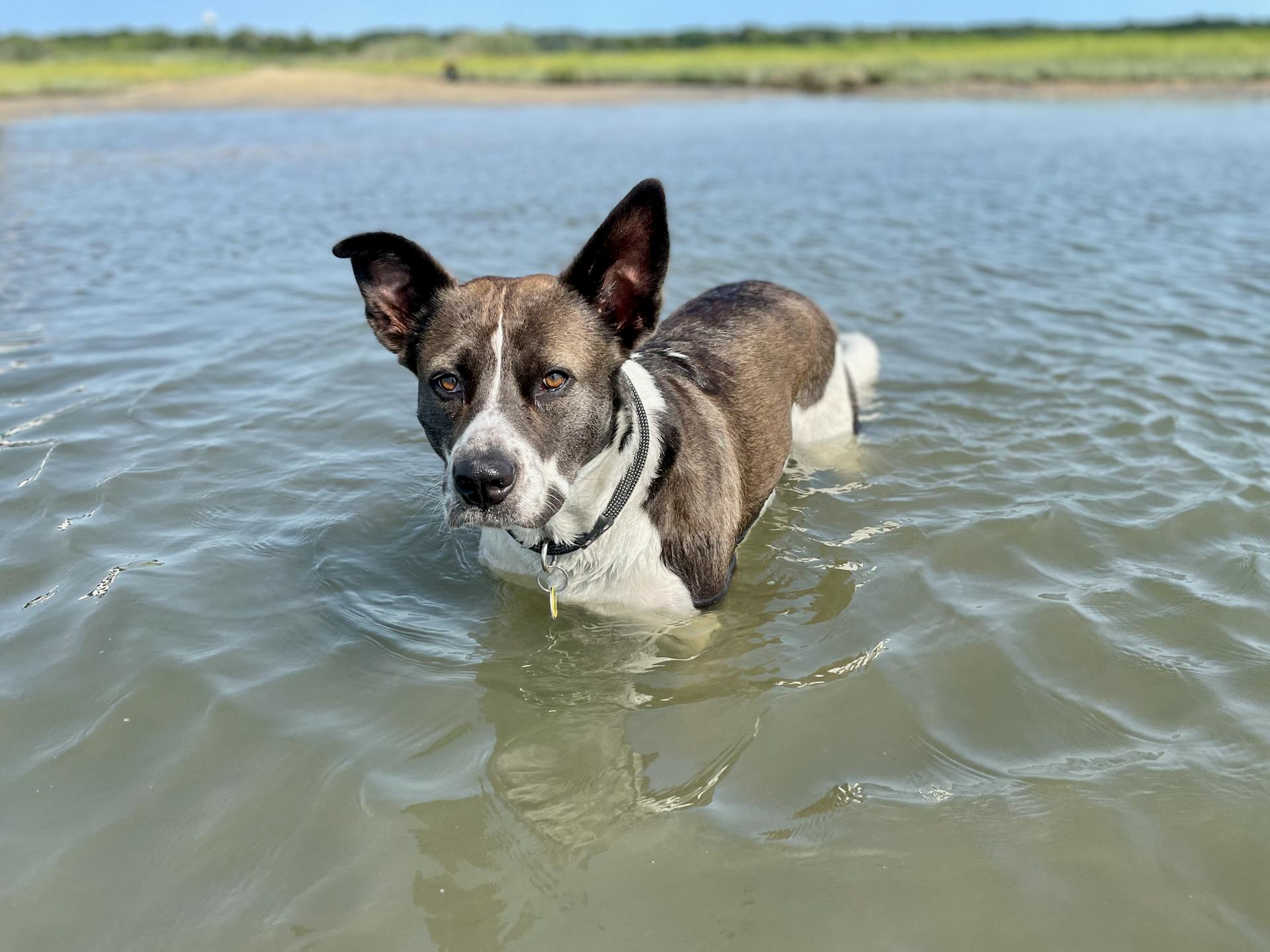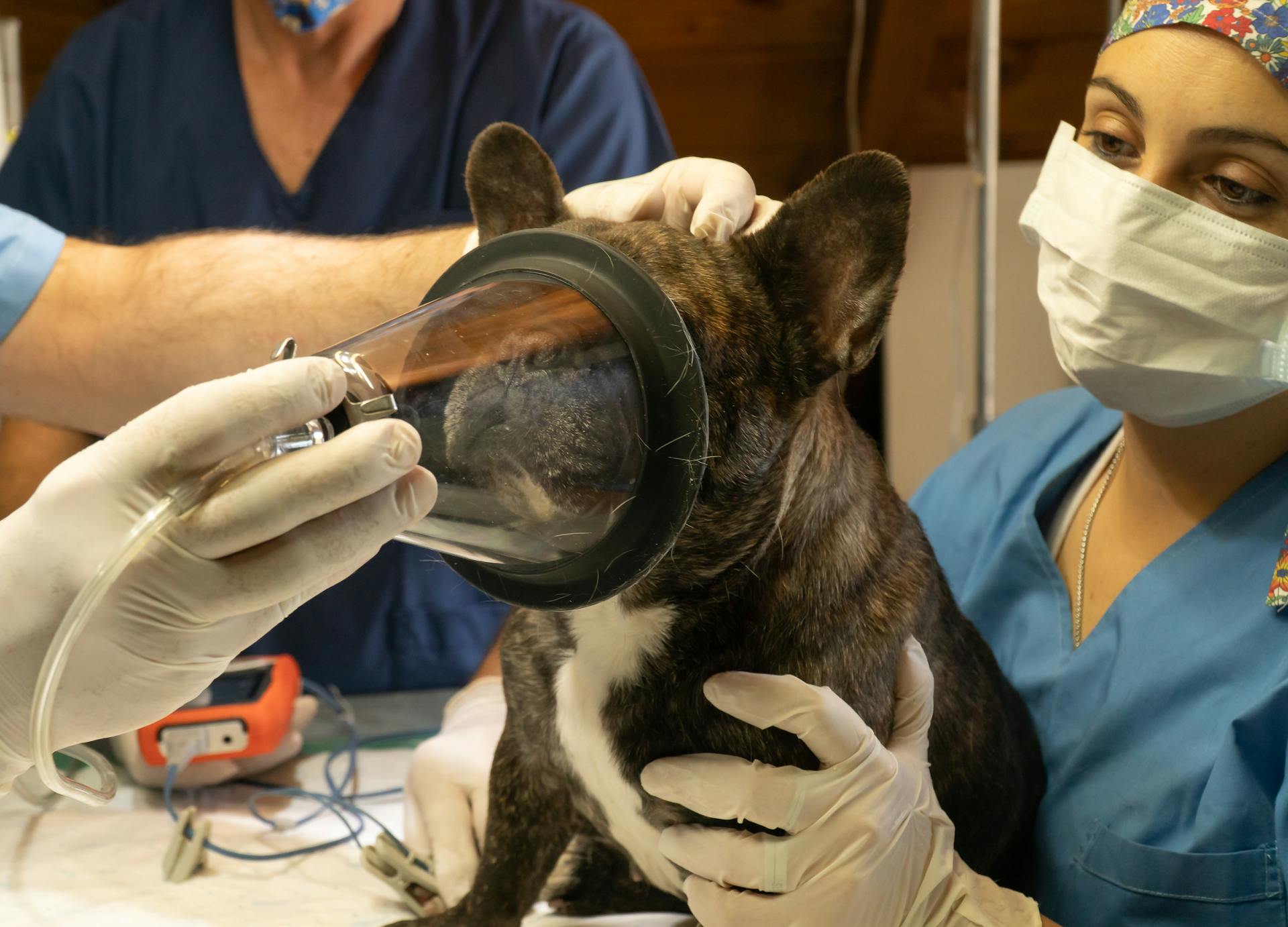
Canine glaucoma is a serious eye condition that affects dogs of all ages, but it's most common in older dogs.
Glaucoma is a group of eye conditions that damage the optic nerve, often due to increased pressure in the eye.
The pressure buildup is usually caused by a blockage in the drainage system of the eye, which can be due to various factors, including genetics, injury, or other health conditions.
Dogs with glaucoma may experience symptoms such as redness, squinting, and sensitivity to light, and in severe cases, vision loss.
Definition and Causes
Canine glaucoma is a complex condition that can be challenging to understand. Glaucoma has been thought of as a "disease of elevated intraocular pressure (IOP)" for over 100 years.
Primary glaucoma is a group of disorders that are typically bilateral, have a strong breed predisposition, and are associated with increasing age. It's documented or believed to have a genetic basis and result in characteristic changes to the optic nerve.
IOP is an important risk factor, but not the sole risk factor for glaucomatous damage. The gonioscopic appearance of the iridocorneal angle (ICA) further categorizes primary glaucoma into "open" and "closed" forms.
Primary glaucoma develops because a dog is born with an abnormality in the part of the eye that drains the fluid from the eye. This part of the eye is named the iridocorneal angle and the fluid is called the aqueous humor.
In most cases of primary glaucoma, the iridocorneal angle is replaced with a sheet of tissue with tiny "flow holes." These small flow holes become obstructed as the dog ages; this prevents the aqueous humor from exiting the eye and the pressure inside the eye increases.
Here are some common causes of glaucoma in dogs:
- Goniodysgenesis is an inherited risk factor for closed-angle glaucoma and puts affected dogs at a higher risk of glaucoma in the future.
- Primary open-angle glaucoma causes a more gradual increase in IOP, and vision loss is very slow.
- Lens luxation occurs when the lens dislocates in front of the iris and blocks the drainage angle.
- Uveitis causes inflammation, debris, and/or scar tissue that blocks the drainage angle, causing fluid accumulation.
- Cataracts can cause inflammation or debris that blocks the drainage angle, leading to fluid accumulation.
- Tumors can lead to physical obstruction and/or inflammation, causing fluid accumulation and a lack of drainage.
- Bleeding in or around the eye from trauma, retinal detachment, etc., can prevent fluid drainage from the iridocorneal angle.
History and Clinical Signs
Canine glaucoma is a painful disease that can cause a range of symptoms in dogs. The pain is often expressed as blepharospasm or general depression, and many owners report a dramatic improvement in their dog's behavior following enucleation of a glaucomatous eye.
One of the most common signs of glaucoma is buphthalmos, which is an increase in the size of the globe due to stretching of the collagen fibers of the cornea and sclera. This is more likely to occur in young patients or those with chronic disease.
The eye will often appear red due to congestion of episcleral vessels. This can be a classic sign of glaucoma, along with other symptoms such as a cloudy or blue appearance to the cornea, and a dilated pupil.
Glaucoma can also cause corneal pathology, including edema and striate keratopathy. The latter is a pathognomonic sign of glaucoma, characterized by white lines in the cornea.
Here are some common signs of glaucoma to look out for:
- Redness around the eye
- Cloudiness of the cornea
- Discharge from the eye
- Pupil dilation
- Enlargement of the eye
- Squinting or a decreased appetite due to pain
Diagnosis
If you notice any changes in your dog's eyes that concern you, bring your pet to a vet as soon as possible because glaucoma is a medical emergency.
A complete ophthalmic exam is the first step in diagnosing glaucoma, and your veterinarian will conduct this exam to assess your dog's eyes.
If this caught your attention, see: Dogs Eyes Swollen from Allergies
Elevated intraocular pressure in one or both eyes confirms glaucoma, which is measured using a tonometer.
A referral to a board-certified veterinary ophthalmologist may be necessary for further testing, such as gonioscopy to evaluate the drainage angles of the eyes.
Ocular ultrasound and/or electroretinography may also be considered by the specialist depending on the presentation and severity of the symptoms.
A gonioscopy test involves placing a specialized lens onto the surface of the eye to visualize the drainage angle and assess whether it appears normal or abnormal.
Specialized ultrasound can also be helpful in diagnosing glaucoma by providing more information about the eye.
Treatment and Outcome
Primary glaucoma requires lifelong treatment, as it's impossible to restore vision that's been lost due to the disease. The goal of therapy is to stabilize the intraocular pressure (IOP) and prevent further vision loss.
The initial treatment for glaucoma in dogs usually involves giving multiple eye drops to reduce the IOP. These drops can often be successful, but the time they work varies by individual dog.
For another approach, see: Lick Granuloma Dog Treatment
Multiple ophthalmic medications are prescribed to lower the IOP to a normal range as quickly as possible. These medications help drain fluid from the eye and include eye drops like carbonic anhydrase inhibitors, prostaglandins, and beta-adrenergic blocking agents.
In severe cases, cyclocryotherapy may be considered to kill the ciliary body cells that produce fluid within the eye. This treatment uses very cold temperatures to reduce the IOP.
Surgical removal of the eye may be necessary in severe cases where the optic nerve has irreversible damage. This eliminates the source of pain and the need for continued glaucoma therapy at home.
The prognosis for dogs with primary glaucoma is typically poor, with many affected dogs becoming blind due to the disease. In cases of secondary glaucoma, the prognosis may be better if the underlying cause can be promptly corrected.
Common Glaucoma Treatments:
- Eye drops (e.g., carbonic anhydrase inhibitors, prostaglandins, and beta-adrenergic blocking agents)
- Analgesics (pain medications)
- Cyclocryotherapy
- Surgical removal of the eye
- Medication implants
- Gonioimplants (small devices that redirect fluid outflow)
Symptoms and Signs
Canine glaucoma is a painful disease that can cause a range of symptoms, from mild to severe. Pain is a common feature of most phases of primary angle closure glaucoma in dogs, and owners may underestimate the degree of discomfort their pet is experiencing.
The symptoms of glaucoma can vary depending on the severity and duration of the condition. In acute glaucoma, symptoms can include a dilated pupil, redness in the whites of the eye, swelling and/or bulging of the eye, and rubbing or scratching at the eye. Some dogs may also become lethargic and show a decrease in appetite.
Here are some key symptoms to look out for:
- Dilated pupils that are nonresponsive to direct light
- Redness in the whites of the eye
- Swelling and/or bulging of the eye
- Rubbing and/or scratching at the eye
- Sleeping more, or acting quieter than usual
- Squinting or avoiding being touched near the affected eye
- Decreased appetite
- Increased watery discharge from the eye
- Sudden blindness — bumping into things, not wanting to move around the house as much and sudden anxiety
It's essential to note that some dogs may show subtle symptoms, such as a cloudy or hazy blueish appearance to the outer layer of the eye, slightly dilated pupils that are slow to respond to light, or plump or slightly distended eye veins in the white of the eye.
What Are the Signs of?
The signs of glaucoma in dogs can be subtle, but there are some key indicators you should look out for. Redness around the eye is a common sign, as well as cloudiness of the cornea.

Dilated pupils are another sign of glaucoma, and they may be slow to respond to light. Swelling and/or bulging of the eye can also occur, and dogs may rub or scratch at the affected eye.
Some dogs may exhibit changes in behavior, such as sleeping more or acting quieter than usual. Squinting or avoiding being touched near the affected eye can also be a sign of glaucoma.
Here are some common signs of glaucoma:
- Redness around the eye
- Cloudiness of the cornea
- Dilated pupils
- Swelling and/or bulging of the eye
- Rubbing or scratching at the eye
- Changes in behavior, such as sleeping more or acting quieter
- Squinting or avoiding being touched near the affected eye
- Sudden blindness
- Decreased appetite
- Increased watery discharge from the eye
It's essential to note that glaucoma can cause pain in dogs, which may lead to behaviors such as holding the eye closed or rubbing at it.
Lens Changes
Age-related changes in lens thickness can lead to anterior chamber shallowing and an increased risk of pupil block in PACG, but these changes are difficult to appreciate with slit-lamp biomicroscopy.
Ultrasonography is the best tool for detecting these changes.
Glaukomflecken are small anterior subcapsular lens opacities that occur due to lens epithelial cell necrosis in humans with PACG.
Optic Disc Changes
Optic disc cupping only occurs in glaucoma. The presence of myelin on the disc surface in dogs with primary angle-closure glaucoma (PACG) can make it difficult to detect optic disc changes.
Early detection of optic disc changes in PACG is extremely challenging due to the myelin. The typical cup/disc ratio used to evaluate the optic disc for glaucomatous changes in humans is 0.3 in normal dogs.
Examination of the optic disc by indirect ophthalmoscopy alone may be insufficient. A pediatric gonioprism is preferred for evaluating the optic disc in dogs with PACG.
The center lens of the pediatric gonioprism allows for a clear view of the optic disc with a slit-lamp biomicroscope.
Changes in Lateral Geniculate Nucleus and Visual Cortex
Glaucoma damage to retinal ganglion cells can lead to degenerative changes in the brain, including the lateral geniculate nucleus and the visual cortex.
Research has shown that even the unaffected eye can drive degenerative changes in the lateral geniculate layers, which is a significant finding.
Histopathologic findings are present in the lateral geniculate layers driven by the unaffected fellow eye, indicating that glaucoma affects more than just the eye.
This has significant implications for therapies aimed at neuroprotection or neuro-regeneration, and highlights the need for a more comprehensive approach to treating glaucoma.
Angle Closure
Angle closure is a critical aspect of canine glaucoma, and understanding it can help you identify potential issues in your furry friend.
Dogs with primary angle closure glaucoma often have gonioscopically visible pectinate ligament dysplasia, a condition that can be associated with various breeds.
Clinical signs of angle closure can be subtle, but they're crucial for early diagnosis.
In many breeds, including American and English cocker spaniels, basset hounds, and miniature poodles, there's a significant female predisposition to angle closure glaucoma. This might be due to a smaller angle opening distance or shorter axial length in females.
Even small changes in angle opening distance can affect aqueous humor flow, making it essential to monitor your dog's eye health.
Angle Closure
Primary angle closure glaucoma is a serious eye condition that can affect dogs of various breeds, but some breeds are more prone to it than others. The breeds that dominate large-scale surveys include American and English cocker spaniels, basset hounds, miniature and toy poodles, great Danes, flat-coated retrievers, chow chows, shar-peis, Welsh springer spaniels, and bouvier des Flandres.

In most breeds, PACG has a significant female predisposition, possibly due to a smaller angle opening distance or shorter axial length compared to male dogs. A smaller angle opening distance can lead to crowding of the ICA, which increases the risk of PACG.
Some dogs may experience intermittent and acute congestive attacks in dim light or under stressful circumstances, such as being groomed or kenneled. These stressors can result in a midrange pupil, making it more susceptible to pupil block.
Pectinate ligament dysplasia (PLD) is a common feature in many breeds affected by PACG. However, not all dogs with PLD will develop PACG in their lifetime, suggesting that other factors are involved in the genesis of this condition.
Fig. 2
In primary open angle glaucoma, the iridocorneal angle is gonioscopically relatively open, as seen in Fig. 2.
High-resolution ultrasound images of the anterior segment show that the iris does not have the same configuration as in PACG, and the ciliary cleft is still open.
The iris configuration is a key differentiator between primary open angle glaucoma and other forms of glaucoma, such as PACG.
In beagles, the iridocorneal angle initially appears open, but it narrows as the disease progresses.
The disease progresses slowly, with increases in IOP occurring over months to years.
Frequently Asked Questions
Can a dog live with glaucoma?
Yes, dogs can live with glaucoma, but it requires ongoing management to prevent further damage. With proper care and medication, many dogs can lead comfortable lives despite their condition.
How quickly does glaucoma progress in dogs?
Glaucoma can progress rapidly in dogs, potentially leading to permanent blindness in a matter of hours or days. All breeds, including mixed breeds, are susceptible to this rapid progression.
What does early glaucoma look like in dogs?
Dogs with early glaucoma may exhibit watery discharge, eye pain, and bulging eyeballs, often accompanied by redness and avoidance of eye contact
Featured Images: pexels.com


